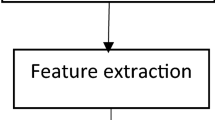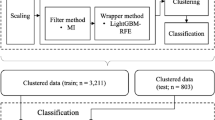Abstract
A major challenge in big and high-dimensional data analysis is related to the classification and prediction of the variables of interest by characterizing the relationships between the characteristic factors and predictors. This study aims to assess the utility of two important machine-learning techniques to classify subjects with obstructive sleep apnea (OSA) using their daytime tracheal breathing sounds. We evaluate and compare the performance of the random forest (RF) and regularized logistic regression (LR) as feature selection tools and classification approaches for wakefulness OSA screening. Results show that the RF, which is a low-variance committee-based approach, outperforms the regularized LR in terms of blind-testing accuracy, specificity, and sensitivity with 3.5%, 2.4%, and 3.7% improvement, respectively. However, the regularized LR was found to be faster than the RF and resulted in a more parsimonious model. Consequently, both the RF and regularized LR feature reduction and classification approaches are qualified to be applied for the daytime OSA screening studies, depending on the nature of data and applications’ purposes.

Graphical Abstract




Similar content being viewed by others
Abbreviations
- AHI:
-
Apnea-Hypopnea Index
- ANOVA:
-
Analysis of variance
- AUC:
-
Area under the curve
- CI:
-
Confidence interval
- LASSO:
-
Least absolute shrinkage and selection operator
- LR:
-
Logistic regression
- MANOVA:
-
Multivariate analysis of variance
- NC:
-
Neck circumference
- OSA:
-
Obstructive sleep apnea
- OOB:
-
Out-of-bag
- PSD:
-
Power spectrum density
- PSG:
-
Polysomnography
- ROC:
-
Receiver operating characteristics
- RF:
-
Random forest
- TBS:
-
Tracheal breathing sounds
References
Power DJ (2014) Using ‘Big Data’ for analytics and decision support. J Decis Syst 23:222–228. https://doi.org/10.1080/12460125.2014.888848
James G, Witten D, Hastie T, Tibshirani R (2013) An introduction to statistical learning. Springer New York, New York
Guyon I, Elisseeff A (2003) An introduction to variable and feature selection. J Mach Learn Res 3:1157–1182. https://doi.org/10.1016/j.aca.2011.07.027
Hastie T, Tibshirani R, Friedman J (2009) The elements of statistical learning. Springer New York, New York
Tibshirani R (2011) Regression shrinkage and selection via the lasso: a retrospective. J R Stat Soc Ser B (Stat Methodol) 73:273–282. https://doi.org/10.1111/j.1467-9868.2011.00771.x
Hajipour F, Jafari Jozani M, Elwali A, Moussavi Z (2019) Regularized logistic regression for obstructive sleep apnea screening during wakefulness using daytime tracheal breathing sounds and anthropometric information. Med Biol Eng Comput 57:2641–2655. https://doi.org/10.1007/s11517-019-02052-4
Breiman L (2001) Random forests. Mach Learn 45:5–32. https://doi.org/10.1023/A:1010933404324
Goldstein BA, Navar AM, Carter RE (2017) Moving beyond regression techniques in cardiovascular risk prediction: applying machine learning to address analytic challenges. Eur Heart J 38:1805–1814. https://doi.org/10.1093/eurheartj/ehw302
Ludwig N, Feuerriegel S, Neumann D (2015) Putting Big Data analytics to work: feature selection for forecasting electricity prices using the LASSO and random forests. J Decis Syst 24:19–36. https://doi.org/10.1080/12460125.2015.994290
Zhao B (2019) A machine learning approach to predicting case duration for Robot-assisted surgery. J Med Syst 43:32
Park JG, Ramar K, Olson EJ (2011) Updates on definition, consequences, and management of obstructive sleep apnea. Mayo Clin Proc 86:549–555. https://doi.org/10.4065/mcp.2010.0810
Kushida CA, Littner MR, Morgenthaler T et al (2005) Practice parameters for the indications for polysomnography and related procedures: an update for 2005. Sleep 28:499–523. https://doi.org/10.1093/sleep/28.4.499
Memtsoudis SG, Besculides MC, Mazumdar M (2013) A rude awakening—the perioperative sleep apnea epidemic. N Engl J Med 368:2352–2353. https://doi.org/10.1056/NEJMp1302941
American Academy of Sleep Medicine (2016) Hidden health crisis costing America billions: underdiagnosing and undertreating obstructive sleep apnea draining healthcare system. Sullivan & Frost, Mountain View
Priftis KN, Hadjileontiadis LJ, Everard ML (2018) Breath sounds from basic science to clinical practice. Springer International Publishing, Cham
Penzel T, Sabil A (2017) The use of tracheal sounds for the diagnosis of sleep apnoea. Breathe 13:e37–e45. https://doi.org/10.1183/20734735.008817
Ayappa I, Rapoport DM (2003) The upper airway in sleep: physiology of the pharynx. Sleep Med Rev 7:9–33. https://doi.org/10.1053/smrv.2002.0238
Sola-Soler J, Fiz JA, Torres A, Jane R (2014) Identification of obstructive sleep apnea patients from tracheal breath sound analysis during wakefulness in polysomnographic studies. Conf Proc Annu Int Conf IEEE Eng Med Biol Soc IEEE Eng Med Biol Soc Annu Conf 2014:4232–4235. https://doi.org/10.1109/EMBC.2014.6944558 (36th Annual International Conference of the IEEE Engineering in Medicine and Biology Society)
Elwali A, Moussavi Z (2017) Obstructive sleep apnea screening and airway structure characterization during wakefulness using tracheal breathing sounds. Ann Biomed Eng 45:839–850. https://doi.org/10.1007/s10439-016-1720-5
Montazeri A, Giannouli E, Moussavi Z (2012) Assessment of obstructive sleep apnea and its severity during wakefulness. Ann Biomed Eng 40:916–924. https://doi.org/10.1007/s10439-011-0456-5
Yadollahi A, Moussavi ZMK (2007) Acoustical flow estimation: review and validation. IEEE Eng Med Biol Mag 26:56–61. https://doi.org/10.1109/MEMB.2007.289122
SIMES RJ (1986) An improved Bonferroni procedure for multiple tests of significance. Biometrika 73:751–754. https://doi.org/10.1093/biomet/73.3.751
Louppe G (2014) Understanding random forests: from theory to practice. Doctoral dissertation, University of Liège
Finkelstein Y, Wolf L, Nachmani A et al (2014) Velopharyngeal anatomy in patients with obstructive sleep apnea versus normal subjects. J Oral Maxillofac Surg 72:1350–1372. https://doi.org/10.1016/j.joms.2013.12.006
Schwab RJ, Pasirstein M, Pierson R et al (2003) Identification of upper airway anatomic risk factors for obstructive sleep apnea with volumetric magnetic resonance imaging. Am J Respir Crit Care Med 168:522–530. https://doi.org/10.1164/rccm.200208-866OC
Schwab RJ, Gupta KB, Gefter WB et al (1995) Upper airway and soft tissue anatomy in normal subjects and patients with sleep-disordered breathing. Significance of the lateral pharyngeal walls. Am J Respir Crit Care Med 152:1673–1689
Bechwati F, Avis MR, Bull DJ et al (2012) Low frequency sound propagation in activated carbon. J Acoust Soc Am 132:239–248. https://doi.org/10.1121/1.4725761
Author information
Authors and Affiliations
Corresponding author
Ethics declarations
The study was approved by the Biomedical Research Ethics Board of the University of Manitoba. All participants signed informed consent before data collection.
Additional information
Publisher’s note
Springer Nature remains neutral with regard to jurisdictional claims in published maps and institutional affiliations.
Rights and permissions
About this article
Cite this article
Hajipour, F., Jozani, M.J. & Moussavi, Z. A comparison of regularized logistic regression and random forest machine learning models for daytime diagnosis of obstructive sleep apnea. Med Biol Eng Comput 58, 2517–2529 (2020). https://doi.org/10.1007/s11517-020-02206-9
Received:
Accepted:
Published:
Issue Date:
DOI: https://doi.org/10.1007/s11517-020-02206-9




